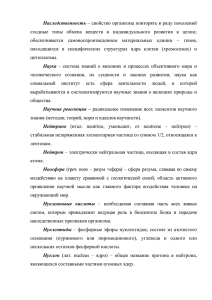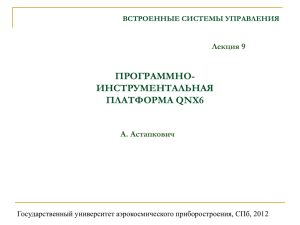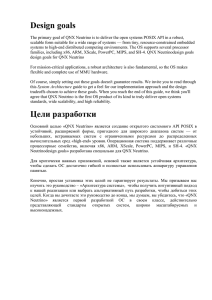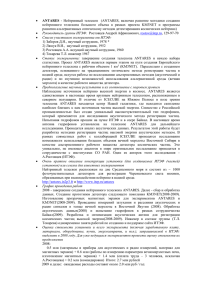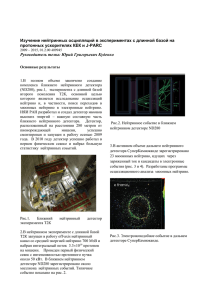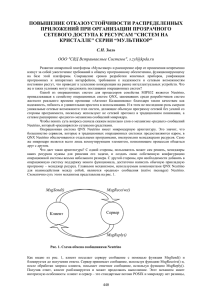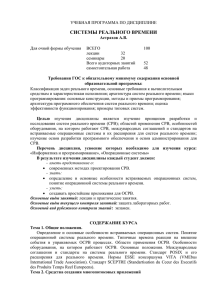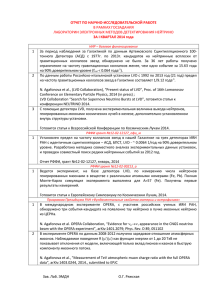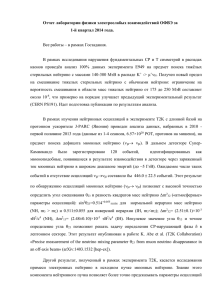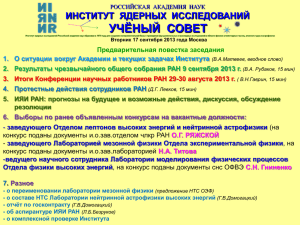Source of the high-energy neutrino
advertisement
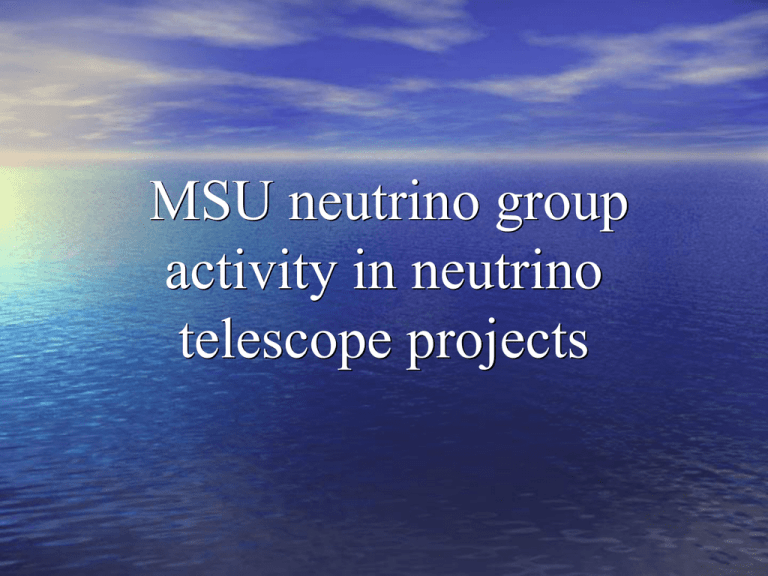
MSU neutrino group activity in neutrino telescope projects Neutrino and registration of them • e , , S = ½ •Reactions of weak interaction •Small cross section of interaction •Neutrinos can provide information about hidden objects in the Universe •Difficulties with registration I. Active galactic nuclei and Gamma-ray bursts (GRB)- are extremely powerful sources of particles and radiation in the Universe II. Protons are deviated by powerful electromagnetic fields (E<1019 eV) of galaxies and interact with sources of electromagnetic fields IV. Only neutrinos can penetrate from the most distant part of the Universe; pass cosmological distance; their direction corresponds to the direction to the source High-energy protons neutrinos Deviation of low energy protons High-energy gamma rays III. Gamma rays interact with a cosmic background (ɣ + ɣ ↔ e + e); they are absorbed in the interstellar space Detection principle The main reactions Big energies=> we can assume that trajectories of the initial protons and final particles agree with accuracy => We can define the location of the source in the space by tracks of neutrinos Current situation • ANTARES (0.09 km^3) Toulon • IceCube (1 куб.км), South Pole • Baikal telescope (0.03 km^3) Baikal, Russia • NEMO KM3Net (1.2 km^3) Capo Passero The main directions of current activities of the MSU scientific group in Mediterranean neutrino projects • Development and creation of optical modules • Modelling and optimization of configuration of neutrino telescopes • • • • • Creation of filters of bioluminescence Development of criteria for the reliability of events Analysis of experimental data (ANTARES) Development of algorithm for the search of supernova Neutrino acoustic (KM3Net) Current research related to neutrino physics • • • • • • Flux of atmospheric muons and neutrino Neutrino oscillations Supernova remnants Periodic sources - microquasars (оne of participants is a black hole or a neutron star) - pulsars (spinning neutron star) active galactic nuclei (black holes) Gamma-ray bursts (merging of double stars, merging of the pair neutron star - black hole, collapse of the star) ANTARES detector a storey 12 lines (about 900 PMTs) 25 storeys / line 3 PMTs/storey 14.5 m 350 m 40 km to shore Horizontal layout 100 m Junction box ~70 m Sea bed ~ -2500 m Interlink cables Structure of the detector Cherenkov method of neutrino registration Atmospheric muon Neutrino passes through the Earth neutrino Земля защищает от атмосферных мюонов. Восходящие мюоны только от нейтрино (космические, атмосферные) ~5000 ФЭУ Reconstruction of the muon track by the time and position of the activated PMT Registration of Cherenkov light III. Мюоны от взаимодействия излучают черенковское излучение мюон Natural water I. Нейтрино, идущие из дальнего космоса, пронизывают Землю, взаимодействуя с веществом Source of the highenergy neutrino Дно Seabed II. Взаимодействуя, нейтрино оставляет после себя заряженный лептон Interaction of neutrino in the Earth’s crust (заряж. ток) Глубина (depth) >3000м Е.В.Широков 22 ноября 2013 г. Учёный Совет НИИЯФ и ОЯФ Distribution of the ratios of rates of muons for experimental data и Monte-Carlo modelling data; fit by Gauss function (Antares) Atmospheric muon veto z [m] 1) All muons which are flying from the atmosphere – background muons 2) The source of muons, which are flying through the Earth, can be neutrinos, but only that neutrinos, which are from beyond Earth 3) Atmospheric muons cannot fly through the Earth (small energy) cosmic neutrinos atmospheric muons R2 [103 m2] detector volume vertex cut R2 [103 m2] S events / 6 months Signal / Noise atmospheric muons atmospheric neutrinos (tracks) atmospheric neutrinos (showers) cosmic neutrinos (tracks) cosmic neutrinos (showers) BDT (topology of event) Прототипы башень Prototypes of towers • НЕМО (NEMO) Фаза-I (Phase-I ) – минибашня (4 этажа) возле порта Катании; small tower (4 floors) near the port of Catania • НЕМО Фаза-II (Phase-II) – башня (8 этажей) Capo passero (3500 м); Tower (8 floors) Capo passero (3500 m) • KM3NeT Фаза 1.5 – НЕМО Фаза-III (Phase-III) – 8 башень по 14 этажей, Capopassero; 8 towers with 14 floors in each tower, Capopassero – 24 струны с МультиФЭУ (24 strings with MultiPMT) НЕМО Фаза-I (NEMO Phase-I) • Установка рядом с портом Катании (installation near to the port of Catania) • Проверка всех ключевых элементов конструкции (сheck all structural elements) • Проверка раскрытия башни (Check the opening of the tower) НЕМО Фаза-II (NEMO Phase- II) • установка на глубине 3500 м (installation at a depth of 3500 m) • более года работы (more than a year of work) НЕМО Фаза-III (NEMO Phase-III) • Установка соединительной коробки и одной струны • (installation of the junction box and one string ) Доведение конфигурации до целого блока (8 струн по 14 этажей по 6 ФЭУ 10’’) bringing up the configuration to the whole block (8 strings with 14 floors with 6 PMT 10 '') KM3Net project • Предполагаемые сроки сооружения (time of developing) – 2012-16 гг. • Предполагаемый объём – 1.2 куб.км (volume 1.2 km^3) Nemo Capo Passero, Italy -3500 m Архитектура architecture нейтринный телескоп neutrino telescope компьютерный центр computer center береговая станция shore station Distance access to data KM3NeT on off удалённый контроль distance control удалённый доступ к данным KM3NeT Фаза-1.5 •24 струны 24 strings •20 Оптических модулей на струне (20 optical modules on a string ) •Оптический модуль (мультиФЭУ) Optical module (multi-PMT) ~ 600 m •8 башень 8 towers •14 этажей в башне 14 floors in the tower •8 м длина этажа length of the floor equals 8 m •height of the floor 20 m •общая. выс. total height. ~ 450 m ~ 450 m ‒31 x 3” ФЭУ 31 x 3“ PMT •6 ОМ+ 2 гидрофона/этаж; 6 OM + 2 ‒LED & акуст. пьезо hydrophone / floor LED & acust. piezo •~ 100 м между башнями ;~ 100 m between ‒FPGA контроль и обработка данных towers FPGA control and data processing Установка installation Disclosure after connecting on the seabed Reusable coil PMT Key features: – Timing ≤ 4.5 ns (FWHM) ETEL D792 Hamamatsu R12199 HZC XP53B20 – QE ≥ 25-30% – collection efficiency ≥ 90% ETEL – photon counting purity 100% (by hits) – price/cm2 ≤ 10” PMT The main results of MSU sсientific group in the Mediterranean sea neutrino projects: • - были разработаны различные прототипы фотоумножителей, которые могут применятся для работы в составе глубоководных телескопов. (various prototypes of photomultipliers have been developed, which can be applied for the work in deep-sea telescopes) • - решена проблемы биолюминисценции, свойственной детекторам, работающим в морской воде. В ходе проведённой работы удалось успешно создать несколько фильтров биолюминисценции, что позволило существенно ускорить расшифровку получаемых сигналов (the problem of bioluminescence was fixed; during the process of this work multiple bioluminescence filters were successfully created, which will significantly speed up the decoding of received signals. • -разработан новый алгоритм поиска сверхновых, используемый для возможного обнаружения данного типа астрофизических объектов, являющихся источниками космических нейтрино. Данный алгоритм существенно улучшает так называемый «коэффициент качества» обработки информации при регистрации нейтринных потоков от возможных вспышек (new algorithm for finding supernovae has been developed; it is used to detect this type of possible astrophysical objects; they are sources of cosmic neutrinos. This algorithm significantly improves a so-called "quality factor" of information processing in registration of neutrino fluxes from possible outbreaks) • -выполнена работа по моделированию различных конфигураций оптических модулей для сооружаемого нейтринного телескопа с объёмом свыше 1 км3. Подобное моделирование позволяет не только повысить эффективность детектора, но и уменьшить затраты на его сооружение (work on modeling of different configurations of optical modules has been processed. This modeling allows not only to improve the efficiency of the detector, but also to reduce the cost of its construction) • - выполнен анализ большого количества экспериментальных данных от детектора ANTARES за период 2008-2010 гг; опробованы несколько различных критериев отбора событий для анализа данных; начаты работы по возможному гидроакустическому обнаружению астрофизических нейтрино (the analysis of a large number of experimental data from the detector ANTARES for the period 2008-2010 has been done; we tested a number of different criteria for the selection of events for analysis; started work on a possible acoustic detection of astrophysical neutrinos) Thank you for your attention
